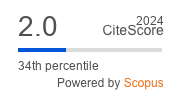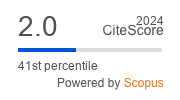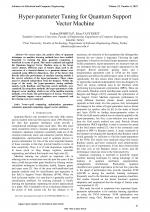| 4/2022 - 6 |
Hyper-parameter Tuning for Quantum Support Vector MachineDEMIRTAS, F. |
| Extra paper information in |
| Click to see author's profile in |
| Download PDF |
Author keywords
grid computing, optimization, parameter estimation, quantum computing, support vector machines
References keywords
quantum(22), learning(16), machine(15), vector(10), support(10), optimization(8), neural(7), systems(6), kernel(6), search(5)
Blue keywords are present in both the references section and the paper title.
About this article
Date of Publication: 2022-11-30
Volume 22, Issue 4, Year 2022, On page(s): 47 - 54
ISSN: 1582-7445, e-ISSN: 1844-7600
Digital Object Identifier: 10.4316/AECE.2022.04006
Web of Science Accession Number: 000920289700006
SCOPUS ID: 85150218461
Abstract
In recent years, the positive effect of quantum techniques on machine learning methods have been studied. Especially in training big data, quantum computing is beneficial in terms of speed. This study examined and applied the Quantum Support Vector Machine steps to the breast cancer dataset. Different types of feature maps used in the conversion of a classical dataset to a quantum dataset were examined using different dimensions. One of the factors that directly affect the performance of machine learning models is the correct selection of the hyper-parameters. These values must be obtained independent from the designer. Within the scope of the study, the hyper-parameter tuning methods, namely, Grid, Random, and Bayesian search methods, were examined. By using these methods, the hyper-parameters of the Support vector machine, which is one of the machine learning methods, were found. The performances of Linear, Non-linear and Quantum support vector machines were compared, and the running costs were analyzed. |
| References | | | Cited By «-- Click to see who has cited this paper |
| [1] C. Gong, Z. Dong, A. Gani, A. et al. "Quantum k-means algorithm based on a trusted server in quantum cloud computing," Quantum Inf Process 20, 130, 2021. [CrossRef] [SCOPUS Times Cited 17] [2] E. Rieffel and W. Polak, "An introduction to quantum computing for non-physicists," ACM Comput. Surv. 32, 3 (Sept. 2000), 300-335. [CrossRef] [SCOPUS Times Cited 257] [3] R. Kohavi, and F. Provost, "Glossary of terms," Machine Learning -Special Issue on Applications of Machine Learning and the Knowledge Discovery Process. Machine Learning, 30, 271-274, 1998. [CrossRef] [4] B. E. Boser, I. M. Guyon, V. N. Vapnik, "A training algorithm for optimal margin classifiers," Proceedings of the Fifth Annual Workshop on Computational Learning Theory, 5, pp. 144-152, 1992. [CrossRef] [5] E. Ozden, D. Guleryuz, "Optimized machine learning algorithms for investigating the relationship between economic development and human capital," Comput Econ (2021). [CrossRef] [SCOPUS Times Cited 15] [6] J. Bergstra, Y. Bengio, "Random search for hyper-parameter optimization," Journal of Machine Learning Research, 13, 281-305, 2012. [7] H. A. Fayed, A. F. Atiya, "Speed up grid search for parameter selection of support vector machines," Applied Soft Computing, 80, 202-210, 2019. [CrossRef] [SCOPUS Times Cited 91] [8] R. G. Mantovani, A. L. D. Rossi, J. Vanschoren, B. Bischl and A. C. P. L. F. de Carvalho, "Effectiveness of random search in SVM hyper-parameter tuning," 2015 International Joint Conference on Neural Networks (IJCNN), 2015, pp.1-8. [CrossRef] [SCOPUS Times Cited 115] [9] R. Chatterjee, T. Yu, "Generalized coherent states, reproducing kernels, and quantum support vector machines," Quantum Inf. Commun. 17, 1292, 2017. [CrossRef] [10] T. Li, S. Chakrabarti, X. Wu, "Sublinear quantum algorithms for training linear and kernel-based classifiers," In: Proceedings of the 36th International Conference on Machine Learning (ICML 2019), vol. PMLR 97, pp. 3815-3824, 2019. [CrossRef] [11] Y. Suzuki, H. Yano, Q. Gao, S. Uno, T. Tanaka, M. Akiyama, N. Yamamoto, "Analysis and synthesis of feature map for kernel-based quantum classifier," Quantum Machine Intelligence, 2(1), 1-9, 2020. [CrossRef] [12] Z. Luo, W. Zhang, Y. Li and M. Xiang, "SVM parameters tuning with quantum particles swarm optimization," 2008 IEEE Conference on Cybernetics and Intelligent Systems, 2008, pp. 324-329. [CrossRef] [SCOPUS Times Cited 7] [13] V. Tkachuk, "Quantum genetic algorithm based on qutrits and its application," Mathematical Problems in Engineering, vol. 2018, Article ID 8614073, 8 pages, 2018. [CrossRef] [SCOPUS Times Cited 23] [14] K. Mitarai, M. Negoro, M. Kitagawa, K. Fujii, "K. Quantum circuit learning," Phys. Rev. A 98, 032309, 2018. [CrossRef] [SCOPUS Times Cited 1015] [15] O. Nairz, M. Arndt, A. Zeilinger, "Quantum interference experiments with large molecules," American Journal of Physics, 71, 319-325, April 2003. [CrossRef] [SCOPUS Times Cited 190] [16] B. E. Boser, I. M. Guyon, V. N. Vapnik, "A training algorithm for optimal margin classifiers," in Proceedings of the fifth annual workshop on Computational learning theory. ACM, 1992, pp. 144-152. [CrossRef] [17] C. Cortes, V. N. Vladimir, "Support-vector networks," Machine Learning. 20 (3): 273-297, 1995. [CrossRef] [18] V. Cherkassky, Y. Ma, "Practical selection of SVM parameters and noise estimation for SVM regression," Neural networks, 17(1), 113-126, 2004. [CrossRef] [SCOPUS Times Cited 1920] [19] S. Huang N. Cai, P. P. Pacheco, S. Narrandes, Y. Wang, W. Xu, "Applications of Support Vector Machine (SVM) learning in cancer genomics," Cancer Genomics Proteomics. 2018; 15(1):41-51. [CrossRef] [SCOPUS Times Cited 1277] [20] S. S. Keerthi, C. J. Lin, "Asymptotic behaviors of support vector machines with Gaussian kernel," Neural computation, 15(7), 1667-1689, 2003,. [CrossRef] [SCOPUS Times Cited 1546] [21] A. Patle and D. S. Chouhan, "SVM kernel functions for classification," 2013 International Conference on Advances in Technology and Engineering (ICATE), 2013, pp. 1-9. [CrossRef] [SCOPUS Times Cited 278] [22] M. Y. Cho, T. T. Hoang, "A differential particle swarm optimization-based support vector machine classifier for fault diagnosis in power distribution systems," Advances in Electrical and Computer Engineering, vol.17, no.3, pp.51-60, 2017. [CrossRef] [Full Text] [SCOPUS Times Cited 8] [23] J. Suykens, J. Vandewalle, Least squares support vector machine classifiers," Neural Processing Letters 9, 293-300, 1999. [CrossRef] [SCOPUS Times Cited 9480] [24] V. Cherkassky, Y. Ma, "Practical selection of SVM parameters and noise estimation for SVM regression," Neural networks, 17(1), pp. 113-126, 2004. [CrossRef] [SCOPUS Times Cited 1920] [25] S. Boughorbel, J. Tarel and N. Boujemaa, "Conditionally positive definite kernels for SVM based image recognition," 2005 IEEE International Conference on Multimedia and Expo, 2005, pp. 113-116. [CrossRef] [SCOPUS Times Cited 57] [26] T. Hofmann, B. Scholkopf, A. J. Smola, "Kernel methods in machine learning," Ann. Statist. Volume 36, Number 3, 1171-1220, 2008. [CrossRef] [27] L. Yang, A. Shami, "On hyperparameter optimization of machine learning algorithms: Theory and practice," Neurocomputing, 415, 295-316, 2020. [CrossRef] [SCOPUS Times Cited 2139] [28] Y. Bao, Z. Liu, "A fast Grid search method in support vector regression forecasting time series," In: Corchado, E., Yin, H., Botti, V., Fyfe, C. (eds) Intelligent Data Engineering and Automated Learning - IDEAL. Lecture Notes in Computer Science, vol 4224. Springer, Berlin, Heidelberg, 2006. [CrossRef] [SCOPUS Times Cited 85] [29] A. C. Florea, A. C. R. Andonie, "Weighted random search for hyperparameter optimization," International Journal of Computers, Communications and Control, 14(2), 2019. [CrossRef] [SCOPUS Times Cited 43] [30] W. Ziyu, H. Frank, Z. Masrour, M. David, F. Nando, "Bayesian optimization in a billion dimensions via random embeddings," Journal of Artificial Intelligence Research. 55: 361-387, 2013. [CrossRef] [SCOPUS Times Cited 316] [31] J. Snoek, H. Larochelle, R. P. Adams, "Practical Bayesian optimization of machine learning algorithms," In Advances in neural information processing systems (pp. 2951-2959), 2012. [CrossRef] [32] J. Virmani, N. Dey, V. Kumar, "PCA-PNN and PCA-SVM based CAD systems for breast density classification. Applications of intelligent optimization in biology and medicine," Cham: Springer; p. 159-80, 2016. [CrossRef] [SCOPUS Times Cited 98] [33] V. Havlicek, A. D. Corcoles, K. Temme, A. W. Harrow, A. Kandala, J. M. Chow, J. M. Gambetta, "Supervised learning with quantum-enhanced feature spaces," Nature, 567(7747), 209-212, 2019. [CrossRef] [SCOPUS Times Cited 1451] [34] T. Goto, Q. H. Tran, K. Nakajima, "Universal approximation property of quantum feature map," arXiv:2009.00298, 2020. Retrieved March 14, 2021, [CrossRef] [SCOPUS Times Cited 64] [35] R. Wille, R. Van Meter and Y. Naveh, "IBM's Qiskit tool chain: Working with and developing for real quantum computers," 2019 Design, Automation & Test in Europe Conference & Exhibition (DATE), 2019, pp. 1234-1240. [CrossRef] [SCOPUS Times Cited 125] [36] G. Uehara, S. Rao, M. Dobson, C. Tepedelenlioglu and A. Spanias, "Quantum neural network parameter estimation for photovoltaic fault detection," 12th International Conference on Information, Intelligence, Systems & Applications (IISA), 2021. pp. 1-7. [CrossRef] [SCOPUS Times Cited 18] [37] Basic Qiskit Syntax [online] Available: https://qiskit.org/textbook/chappendix/qiskit.html [38] C. Blank D. K. Park, J. K. K. Rhee, F. Petruccione, "Quantum classifier with tailored quantum kernel," npj Quantum Inf 6, 41, 2020. [CrossRef] [SCOPUS Times Cited 120] [39] Dataset.Available:https://archive.ics.uci.edu/ml/datasets/breast+cancer+wisconsin+(diagnostic). [40] S. Vashisth, I. Dhall, G. Aggarwal, "Design and analysis of quantum powered support vector machines for malignant breast cancer diagnosis," Journal of Intelligent Systems,30(1), 998-1013, 2021. [CrossRef] [SCOPUS Times Cited 22] [41] P. Rebentrost, M. Mohseni, S. Lloyd, "Quantum support vector machine for big data classification," Physical review letters Vol.113, Iss.13, 130503, 2014. [CrossRef] [SCOPUS Times Cited 1396] Web of Science® Citations for all references: 0 SCOPUS® Citations for all references: 24,093 TCR Web of Science® Average Citations per reference: 0 SCOPUS® Average Citations per reference: 574 ACR TCR = Total Citations for References / ACR = Average Citations per Reference We introduced in 2010 - for the first time in scientific publishing, the term "References Weight", as a quantitative indication of the quality ... Read more Citations for references updated on 2025-07-01 02:04 in 250 seconds. Note1: Web of Science® is a registered trademark of Clarivate Analytics. Note2: SCOPUS® is a registered trademark of Elsevier B.V. Disclaimer: All queries to the respective databases were made by using the DOI record of every reference (where available). Due to technical problems beyond our control, the information is not always accurate. Please use the CrossRef link to visit the respective publisher site. |
Faculty of Electrical Engineering and Computer Science
Stefan cel Mare University of Suceava, Romania
All rights reserved: Advances in Electrical and Computer Engineering is a registered trademark of the Stefan cel Mare University of Suceava. No part of this publication may be reproduced, stored in a retrieval system, photocopied, recorded or archived, without the written permission from the Editor. When authors submit their papers for publication, they agree that the copyright for their article be transferred to the Faculty of Electrical Engineering and Computer Science, Stefan cel Mare University of Suceava, Romania, if and only if the articles are accepted for publication. The copyright covers the exclusive rights to reproduce and distribute the article, including reprints and translations.
Permission for other use: The copyright owner's consent does not extend to copying for general distribution, for promotion, for creating new works, or for resale. Specific written permission must be obtained from the Editor for such copying. Direct linking to files hosted on this website is strictly prohibited.
Disclaimer: Whilst every effort is made by the publishers and editorial board to see that no inaccurate or misleading data, opinions or statements appear in this journal, they wish to make it clear that all information and opinions formulated in the articles, as well as linguistic accuracy, are the sole responsibility of the author.



